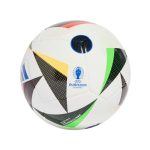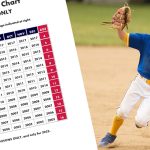For 8 year olds, a size 4 soccer ball is recommended. When choosing a soccer ball for 8 year olds, it is important to consider their age and size.
The appropriate ball size for this age group is the size 4 soccer ball. This size is specifically designed to fit comfortably in the feet of young players, allowing them to practice and develop their skills effectively. Using the correct ball size not only enhances their playing experience but also promotes proper technique and control.
In addition, a size 4 ball is lighter and easier to handle, making it more suitable for the physical capabilities and strength of 8 year olds. Understanding and selecting the right ball size contributes to a positive and enjoyable soccer experience for young players.
Factors To Consider
When selecting a soccer ball for 8-year-olds, it’s important to consider the appropriate size. Choosing a ball that is the right size will ensure their comfort and enhance their playing experience.
Factors to Consider When selecting a soccer ball for 8-year-olds, there are several factors that you need to consider. These factors include the age and size of the child, as well as the safety and comfort of the ball. Additionally, you should take into account the child’s skill level and playing style. Each of these factors plays a crucial role in determining the right size soccer ball for your child. Let’s dive into each factor in more detail.Age And Size Of The Child
The age and size of your child are important considerations when choosing the right soccer ball. As children grow at different rates, it’s essential to select a ball suitable for their age group. For 8-year-olds, a Size 4 soccer ball is typically recommended. This size is smaller and lighter than the standard Size 5 ball used by adults and older children. Opting for a smaller size ensures that the child can properly control and maneuver the ball, enhancing their overall playing experience.Safety And Comfort
Safety and comfort are paramount when it comes to soccer equipment, and this includes the soccer ball. When choosing a ball for an 8-year-old, it’s crucial to consider the material and construction. Look for balls made from high-quality and durable materials that can withstand the rigors of play. Additionally, consider the ball’s weight and bounce. A ball that is too heavy or has excessive bounce may pose a safety risk for younger players. Ensure the ball is comfortable to kick, throw, and catch to promote an enjoyable and injury-free experience.Skill Level And Playing Style
Another important factor to consider is the child’s skill level and playing style. Different balls are designed to cater to specific skill levels, so choosing the right ball can help your child further develop their soccer abilities. For beginners and recreational players, a softer and more forgiving ball may be ideal. On the other hand, advanced players might benefit from a ball with better control and responsiveness. Consider your child’s playing style as well, whether they prefer a lightweight ball for speed or a heavier one for more power. Taking these factors into account ensures that the ball complements your child’s abilities and helps them reach their full potential on the pitch. In conclusion, selecting a soccer ball for 8-year-olds involves considering the age and size of the child, ensuring safety and comfort, as well as taking into account their skill level and playing style. By carefully considering these factors, you can choose the appropriate ball that will enhance your child’s soccer experience and contribute to their overall growth and development in the sport.Recommended Sizes For 8 Year Old Soccer Players
Choosing the right soccer ball size is crucial for young players, as it can significantly impact their performance on the field. For 8 year olds, there are two main options to consider: the size 3 soccer ball and the size 4 soccer ball. Each size has its own benefits and considerations, so let’s explore them in detail.
Size 3 Soccer Ball: The Optimal Choice
The size 3 soccer ball is the recommended choice for most 8 year old soccer players. This ball is smaller and lighter than its larger counterparts, making it easier for young athletes to handle, control, and kick with precision. The smaller size helps promote proper technique and allows players to develop their skills more effectively.
Benefits of Using a Size 3 Ball
There are several significant benefits to using a size 3 soccer ball for 8 year olds:
- Improved Technique: The smaller size encourages players to focus on proper foot placement, ball control, and accuracy, helping them refine their skills at an early age.
- Enhanced Control: With a more manageable size, young players can develop better ball control, enabling them to dribble, pass, and shoot with greater accuracy and confidence.
- Reduced Risk of Injury: The lighter weight of the size 3 ball reduces the risk of strain and injury on young players’ muscles and joints, allowing them to play comfortably for extended periods.
- Increased Confidence: Successfully handling a smaller ball can boost a player’s self-assurance and motivation, empowering them to take on more challenging moves and techniques.
Size 4 Soccer Ball: An Alternative Option
While the size 3 soccer ball is generally recommended for 8 year olds, there may be situations where a size 4 ball is more suitable. It’s important to carefully consider the specific needs and abilities of the player before opting for a larger size.
When to Consider a Size 4 Ball
Here are a few scenarios in which a size 4 soccer ball might be a better choice:
- Physical Capabilities: If the 8 year old player is physically advanced and possesses greater strength and coordination, a size 4 ball may provide a better challenge to enhance their skills.
- Playing at Higher Levels: If the young player is participating in more competitive leagues or tournaments, using a size 4 ball may better simulate match conditions and help them adapt to the game’s intensity.
- Personal Preferences: Ultimately, some players simply feel more comfortable with a size 4 ball due to personal preferences or previous experience, making it a viable option.
Advantages and Disadvantages
While a size 4 soccer ball may have its merits, it’s essential to consider both the advantages and disadvantages:
| Advantages | Disadvantages |
|---|---|
| Greater challenge for advanced players | Potential increased risk of strain or injury |
| Better simulation of match conditions | Higher weight can hinder technique development |
| Potential decrease in confidence for less physically advanced players |
Ultimately, the choice between a size 3 and size 4 soccer ball for an 8 year old player depends on various factors, including skill level, physical capabilities, and personal preference. It’s essential to evaluate these considerations to ensure the optimal ball size is selected, enabling young players to develop their skills, technique, and love for the game.
How To Choose The Right Size Soccer Ball For An 8 Year Old
Choosing the right size soccer ball for your 8-year-old is an important decision that can greatly impact their performance and enjoyment of the game. A ball that is too small or too big can affect their ability to control it and may even lead to injuries. In this article, we will guide you through the process of selecting the perfect soccer ball size for your 8-year-old, taking into consideration factors such as their height, weight, position, and playing environment.
Measuring The Child’s Height And Weight
When determining the appropriate soccer ball size for your 8-year-old, it’s essential to take into account their height and weight. The size of the ball should be directly proportional to their body size and strength. Here are general guidelines to help you choose:
- For children with a height between 3’6″ and 4’4″ and weighing between 55-70 pounds, a size 4 soccer ball is usually the most suitable option.
- For those who are taller than 4’4″ or heavier than 70 pounds, a size 5 soccer ball, which is the standard for adults, might be better suited for their needs.
Considerations For Position And Playing Environment
Another factor to consider when choosing the right size soccer ball for an 8-year-old is their position on the field and the playing environment. Different positions require various levels of control and precision. For example:
| Position | Ideal Soccer Ball Size |
|---|---|
| Goalkeeper | Size 4 or 5 |
| Midfielder | Size 4 or 5 |
| Defender | Size 4 or 5 |
| Forward | Size 4 or 5 |
Considering the playing environment is also crucial. If your child mainly plays on a grass field, a standard soccer ball is suitable. However, if they frequently play indoors or on artificial turf, a futsal ball or a ball specifically designed for artificial surfaces may be a better choice.
Testing Different Soccer Ball Sizes
Ultimately, it’s essential to test different soccer ball sizes to determine which one feels the most comfortable to your 8-year-old. Let them try out various sizes and observe how they handle each ball. Look for signs of control, accuracy, and overall ease of play. It’s essential that the ball allows them to develop their skills and improve their performance on the field.
By measuring your child’s height and weight, considering their position and playing environment, and testing different soccer ball sizes, you can make an informed decision and find the perfect size soccer ball for your 8-year-old. Remember, a properly sized ball will not only enhance their performance but also make the game more enjoyable for them.
Importance Of Using The Correct Size Soccer Ball
Choosing the right size soccer ball is crucial for young players, especially for 8-year-olds who are still developing their skills and coordination. Using the correct size ball can have a significant impact on their performance, technique, and overall enjoyment of the game. Let’s explore the various reasons why it is so important to use the appropriate size soccer ball:
Enhancing Performance And Technique
Using a soccer ball that is the right size for 8-year-olds can greatly enhance their performance on the field. When the ball is too big or too small, it becomes more challenging to control and manipulate, affecting their passes, shots, and dribbling ability. By using a ball specifically designed for their age group, young players can develop better ball control, improve their footwork, and build confidence in their skills. This allows them to focus on learning proper technique and honing their abilities, ultimately leading to a more enjoyable playing experience.
Reducing The Risk Of Injuries
Another crucial aspect of using the correct size soccer ball is the reduction of injuries. When a ball is too big or heavy for an 8-year-old player, they may struggle to kick or handle it, leading to improper technique and increased strain on their muscles and joints. This can result in unnecessary injuries such as pulled muscles or sprained ankles. On the other hand, using a ball that is too small for their age group can lead to overexertion as they have to put in more effort to control it. By providing young players with the right size ball, we can ensure their safety on the field and minimize the risk of potential injuries.
Promoting Love For The Game
The correct size soccer ball plays a significant role in promoting a love for the game among 8-year-olds. When children can comfortably handle and manipulate the ball, they experience a sense of joy and accomplishment. This positive experience fosters a passion for soccer and encourages youngsters to continue playing and improving their skills. Additionally, the ability to effectively interact with the ball allows them to participate more fully in team activities, creating a stronger sense of camaraderie and a deeper connection with the sport. By providing young players with a soccer ball that suits their age and abilities, we can cultivate a lifelong love for the game and lay the foundation for future success in their soccer journey.
Using the correct size soccer ball is not just a matter of convenience or preference; it is an essential aspect of a young player’s development. By enhancing their performance, reducing the risk of injuries, and promoting a love for the game, the right size ball ensures a more enjoyable and rewarding soccer experience for 8-year-olds. So, make sure to choose the right size ball for your young player and watch as their skills and passion for the game flourish!
Maintaining And Caring For The Soccer Ball
Proper maintenance and care of your child’s soccer ball are essential to ensure its longevity and optimal performance. By following a few simple steps, you can keep the ball in excellent condition, allowing your young athlete to enjoy many games and practices without any issues.
Proper Inflation And Storage
One of the most important aspects of maintaining a soccer ball is to keep it properly inflated. A soccer ball that is underinflated or overinflated can significantly affect its bounce and feel during play.
To check for the correct inflation, locate the recommended pressure range printed on the ball. Typically, it is indicated in pounds per square inch (PSI). Use a pressure gauge to ensure the ball is inflated to the appropriate level.
When storing the soccer ball, it’s important to keep it away from extreme temperatures and prolonged exposure to sunlight. Excessive heat or direct sunlight can cause the ball to deteriorate faster, leading to cracks or loss of shape. Store the ball in a cool, dry place where it is not vulnerable to extreme temperature fluctuations.
Cleaning And Maintenance Tips
Regular cleaning of the soccer ball is essential to remove dirt, mud, and grass stains that accumulate during play. Follow these simple cleaning tips to keep the ball looking its best:
- Wipe the ball with a damp cloth or sponge to remove any visible dirt or debris.
- If the ball is heavily soiled, mix a mild detergent with warm water and gently scrub the surface with a soft brush.
- Rinse the ball thoroughly with clean water to remove any detergent residue.
- Allow the ball to air dry completely before using it again or storing it.
Remember, using harsh chemicals or abrasive cleaners can damage the ball’s surface and affect its performance, so it’s best to stick to mild cleaning agents.
When To Replace The Soccer Ball
Even with proper care, soccer balls will eventually wear out and need to be replaced. Here are a few signs that indicate it’s time for a new ball:
- If the outer cover starts to crack, peel, or show significant signs of wear, it can affect the ball’s flight and trajectory.
- If the bladder inside the ball loses its shape or starts to leak air, it’s time for a replacement.
- If the ball no longer holds the correct inflation even after re-inflating, it may have structural damage that cannot be repaired.
By paying attention to these signs, you can ensure your child plays with a soccer ball that is safe and performs optimally.

Credit: www.amazon.com
Frequently Asked Questions Of What Size Soccer Ball For 8 Year Olds
What Size Soccer Ball Should I Get For An 8-year-old?
For 8-year-olds, a size 3 soccer ball is recommended. This size allows them to comfortably control the ball without it being too heavy or difficult to kick. It’s important to use the right size to help develop their skills and ensure they enjoy the game.
How Do I Know If The Soccer Ball Is The Right Size For My 8-year-old?
To check if a soccer ball is the right size for your 8-year-old, have them stand with their legs shoulder-width apart and ask them to hold the ball between their knees. If the ball touches their knees or comes just below them, it’s the right size.
If it’s too big or too small, consider getting a different size to ensure proper development and enjoyment.
Can My 8-year-old Play With A Size 4 Soccer Ball?
While an 8-year-old can play with a size 4 soccer ball, it’s generally recommended to use a size 3. The smaller size is easier for them to control and kick, helping them develop their skills and enjoy the game. However, if your child is comfortable with a size 4 ball and can handle it properly, it can be used as well.
What If My 8-year-old Is Bigger Or Smaller Than Average?
If your 8-year-old is bigger or smaller than average, it’s still important to consider their age for selecting the soccer ball size. While their physical attributes may vary, using a size 3 soccer ball is typically suitable for most 8-year-olds.
However, if they are struggling to control the ball or finding it too easy, you can consider moving up or down a size accordingly.
Conclusion
Selecting the right size soccer ball for 8-year-olds is crucial for their development, coordination, and enjoyment of the game. By considering factors such as their age, size, and skill level, parents and coaches can ensure a suitable ball that promotes proper technique and prevents injuries.
Remember, investing in the right soccer ball sets the foundation for a successful soccer journey for young players.

General Manager & Auditorial Head.
Killian Jake is a World Sports Traveler and hobbyist sports lover. By exploring different sorts of playing modules like indoor, outdoor, and many more. As for professionalism and writing, it’s helpful to give you the right suggestions on different games and sports.





